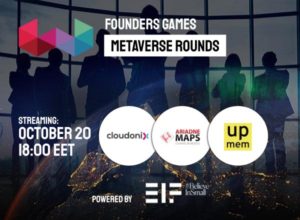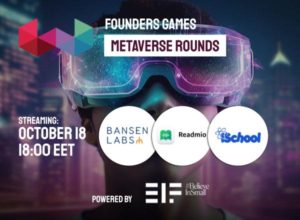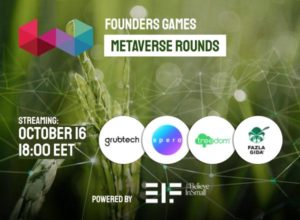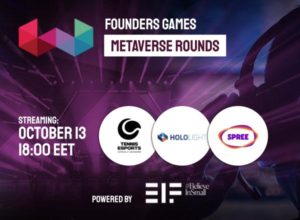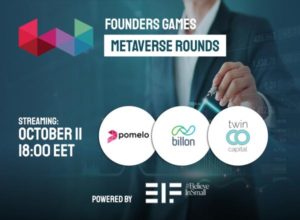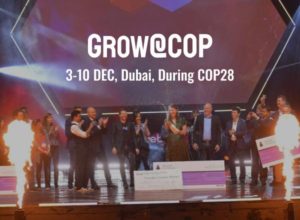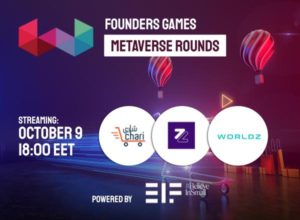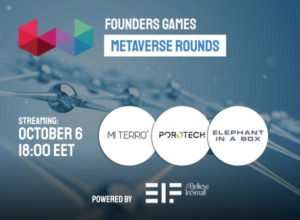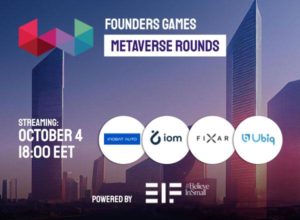Metaverse Rounds Episode 9: Enterprise Pitch
🌟 Prepare for an upcoming and thrilling episode of the Founder's Games Metaverse Rounds, brought to you by the European Investment Fund (EIF) 🌟
Today, we're delving deep into the world of #Enterprise! 💼
Nir Simionovich, CEO, Cloudonix
Georgios Pipelidis, Co-Founder & MD, Ariadne Maps
Gilles Hamou, Co-Founder & CEO, Upmem
Join us to witness the exceptional visionaries of the startup realm taking center stage.
Meet our distinguished panel of judges:
Philipp Schroeder, Endeit Capital
Patrick Lord, Truffle Capital
Ida Kuijken, Fortino Capital
Plamen Russev Ph.D., Webit Investment Network
📅 Don't forget to mark your calendar! Be sure to tune in at 6:00 pm EET to be a part of this incredible opportunity. 📅
Link: https://www.foundersgames.org/2023/event-2023-10-enterprise.php
The Founders Games and the TV series are exclusive trademarks and intellectual properties of Webit Foundation - all rights reserved.
🌟🚀 #FoundersGames #MetaverseRounds #EIF
Metaverse Rounds Episode 8: EdTech Pitch
🌟Prepare for an exhilarating new episode of the Founder's Games Metaverse Rounds, powered by the European Investment Fund (EIF) 🌟
🎓 Today, we are immersing ourselves in the world of #EdTech! 📚
🙌 Join us to witness the extraordinary visionaries of the startup world taking center stage.
Ray Abel, CEO, Bansen Labs
Ilya Novodvorskiy, Co-Founder, Readmio
Ibrahim Abdullah, Co-Founder & CEO, iSchool
👋 Meet our respected panel of judges:
Hidde Hoogcarspel, Co-Founder & Managing Partner, DFF (Dutch Founders Fund)
Vlad Sarca, Partner, Sparking Capital
Bakhrom I., Partner, Molten Ventures
Plamen Russev, Ph.D., Webit Investment Network
📅 Save the date! Tune in at 6:00 pm EET and ensure you're part of this incredible opportunity.
Link: https://www.foundersgames.org/2023/event-2023-10-edtech.php
The Founders Games and the TV series are trademarks and intellectual properties of Webit Foundation - all rights reserved.
🌟🚀 #FoundersGames #MetaverseRounds #EIF
Metaverse Rounds Episode 7: FoodTech and AgTech Pitch
🚀 Get ready for another exciting episode of the Founder's Games Metaverse Rounds, brought to you by the European Investment Fund (EIF)! 🌟
Today, we're delving into the realms of FoodTech and AgTech.
Join us and be amazed by the remarkable startup leaders who will be in the spotlight. 📺
Phaedra Randolph, CEO & Founder, Spero Foods
Federico Garcea, CEO & Founder, Treedom
Koray Kocer, CMO, FazlaGıda
You won't want to miss the chance to meet our impressive panel of judges:
Ting-Ting Liu, Prosus
Laila Hassan, Algebra Ventures
Julia Sohajda, Vespucci Partners
Plamen Russev, Ph.D., Webit Investment Network
🎯 #FoundersGames, powered by the European Investment Fund (EIF) proudly endorses and grants investment awards of up to $6 million to the most rapidly expanding scaleups that drive positive societal and environmental change.
🌎 #FoundersGames stands as the sole global platform harnessing the collective intelligence of over 250 investors. Late-stage VCs, family offices, corporate VCs, and private investors diligently evaluate and rate the companies that navigate through 5 rounds of rigorous selection. The competition welcomes companies from 17 industry verticals, spanning from seed to Series C stages.
📅 Mark your calendars! Tune in at 6:00 pm EET and make sure you don't miss out on this fantastic opportunity. 📅
Link: https://www.foundersgames.org/2023/event-2023-10-foodtech.php
🌟🚀 #F](https://www.foundersgames.org/2023/event-2023-10-foodtech.php)oundersGames #MetaverseRounds #EIF
Metaverse Rounds Episode 6: Media and Entertainment Pitch
🚀 Brace yourselves for the upcoming Founder's Games Metaverse Rounds episode, powered by the European Investment Fund (EIF)! 🌟
Today, we're diving deep into the world of Media & Entertainment.
Tune in and be wowed by the amazing startup leaders taking center stage. 📺
Gregory Gettinger, Founder & CEO, Tennis Esports
Susanne Haspinger, COO, Holo-Light
Jontahan Nowak, CEO, SPREE Interactive
Don't miss meeting our impressive panel of judges:
Vinay Solanki, Channel 4 Ventures
Peter Vanbekbergen, imec.xpand
Bakhrom Ibragimov , Partner, Molten Ventures
Plamen Russev, Ph.D Russev, Webit Investment Network
🎯 Founders Games, powered by the European Investment Fund (EIF) proudly endorses and grants investment awards of up to $6 million to the most rapidly expanding scaleups that drive positive societal and environmental change.
🌎 Founders Games stands as the sole global platform harnessing the collective intelligence of over 250 investors. Late-stage VCs, family offices, corporate VCs, and private investors diligently evaluate and rate the companies that navigate through 5 rounds of rigorous selection. The competition welcomes companies from 17 industry verticals, spanning from seed to Series C stages.
📅 Mark your calendars! Tune in at 6:00 pm EET and make sure you don't miss out on this fantastic opportunity. 📅
Link: https://www.foundersgames.org/2023/event-2023-10-media.php
The Founders Games and the TV series are trademarks and intellectual properties of Webit Foundation - all rights reserved.
🌟🚀 #FoundersGames #MetaverseRounds #EIF
Metaverse Rounds Episode 5: Financial technologies, DeFi Pitch
re you ready for the next epic episode of Founder's Games Metaverse Rounds? 🚀
Today's episode, brought to you by EIF, is all about Fintech and DeFi.
👋 Join us as we watch these amazing startup leaders steal the spotlight. 🌟
Gaston Irigoyen, CEO, Pomelo
JacekFigula, Chief Commercial Officer, Billon
Sandra Nolasco, CEO, Twinco Capital
➡️ Meet our incredible panel of judges:
Max Bautin, Co-founder & Managing Partner, IQ Capital
Aleksandra Laska, Partner, Redalpine Venture Partners
Marcin Laczynski, Partner, Next Road Capital
Alexander Galitsky, Almaz Capital
Plamen Russev, Ph.D, of Webit Investment Network
🎯 Founders Games, powered by the European Investment Fund (EIF), proudly endorses and grants investment awards of up to $6 million to the most rapidly expanding scaleups that drive positive societal and environmental change.
🌎 Founders Games stands as the sole global platform harnessing the collective intelligence of over 250 investors. Late-stage VCs, family offices, corporate VCs, and private investors diligently evaluate and rate the companies that navigate through 5 rounds of rigorous selection. The competition welcomes companies from 17 industry verticals, spanning from seed to Series C stages.
📅 Save the date! Set your alarms for 6:00 pm EET and make sure you don't miss out on this fantastic opportunity. 📅 Tune in here:
https://www.foundersgames.org/2023/event-2023-10-fintech.php
The Founders Games and the TV series are trademarks and intellectual properties of Webit Foundation - all rights reserved.
🌟🚀 #FoundersGames #MetaverseRounds #EIF
GROW@COP – Sustainable Innovation Startup Challenge during COP28 in Dubai
🚀The COP28 Presidency of the United Nations has chosen and invited Webit to showcase global innovations aimed at addressing climate challenges. The forum will culminate in a special Webit ceremony called GROW@COP, to be held at the COP28 Presidency Conference Center.
✨ During this ceremony, Webit will announce the top 5 companies (selected through the five rounds of Founders Games) that have the potential to contribute significantly to finding global solutions. Webit is the founder of the global innovation program and platform known as Founders Games.
👉 This recognition, coming from the highest level, for our impact on innovation and sustainable development, is perhaps one of the most significant moments in Webit's history and is bestowed by the most important global organization.
🤝 Webit Foundation, in partnership with UICCA, led by Her Highness Sheikha Shamma personally, will host eight events during COP28 of the United Nations this year. This is further proof of the impact and influence that our global Webit community possesses and serves as an even greater incentive for our team to work towards creating value for our country and the world.
The thematic days of the event during COP28 are as follows:
 HEALTH / RELIEF / RECOVERY AND PEACE
-
Date: December 3rd
Location: Pavilion, Knowledge Hub, Green Zone
HEALTH / RELIEF / RECOVERY AND PEACE
-
Date: December 3rd
Location: Pavilion, Knowledge Hub, Green Zone |
 FINANCE / TRADE / GENDER EQUALITY / ACCOUNTABILITY
-
Date: December 4th
Location: UICCA Location: Pavilion, Knowledge Hub, Green Zone
FINANCE / TRADE / GENDER EQUALITY / ACCOUNTABILITY
-
Date: December 4th
Location: UICCA Location: Pavilion, Knowledge Hub, Green Zone |
 ENERGY / INDUSTRY AND JUST TRANSITION
-
Date: December 5th
Location: Pavilion, Knowledge Hub, Green Zone
ENERGY / INDUSTRY AND JUST TRANSITION
-
Date: December 5th
Location: Pavilion, Knowledge Hub, Green Zone |
 MULTILEVEL ACTION / URBANIZATION AND BUILT ENVIRONMENT / TRANSPORT
-
Date: December 6th
Location: Pavilion, Knowledge Hub, Green Zone
MULTILEVEL ACTION / URBANIZATION AND BUILT ENVIRONMENT / TRANSPORT
-
Date: December 6th
Location: Pavilion, Knowledge Hub, Green Zone |
 FOOD / AGRICULTURE AND WATER
-
Date: December 8th
Location: Pavilion, Knowledge Hub, Green Zone FOOD / AGRICULTURE AND WATER
-
Date: December 8th
Location: Pavilion, Knowledge Hub, Green Zone |
 YOUTH / CHILDREN / EDUCATION AND SKILLS
-
Date: December 8th
Location: Youth Pavilion, Green Zone
YOUTH / CHILDREN / EDUCATION AND SKILLS
-
Date: December 8th
Location: Youth Pavilion, Green Zone |
 NATURE / LAND USE AND OCEANS
-
Date: December 9th
Location: Pavilion, Knowledge Hub, Green Zone
NATURE / LAND USE AND OCEANS
-
Date: December 9th
Location: Pavilion, Knowledge Hub, Green Zone |
 GROW@COP GRAND FINALS GALA CEREMONY
-
Date: December 10th
Location: Main Conference Center of COP28 Presidency GROW@COP GRAND FINALS GALA CEREMONY
-
Date: December 10th
Location: Main Conference Center of COP28 Presidency |
Metaverse Rounds Episode 4: E-commerce and Logistics
🚀 Metaverse Rounds by Founders Games, in partnership with the European Investment Fund (EIF), is advancing to its next episode, centering its discussion on the realms of e-commerce and logistics.
🔥 Join us in witnessing these innovative startup leaders take the stage:
Cyrille Jacques, Co-Founder & Chief Strategy Officer at Chari
Giulia Mena, Co-Founder of ZIM Connections
Joshua Priore, CEO of Worldz
🌟 Our distinguished panel of judges comprises:
Wissam Mansour from Neventa Capital
Riccardo Cirillo from DIP Capital
Louise Hagen representing Luminar Venture
Plamen Russev, Ph.D., of Webit Investment Network
Founders Games, powered by the European Investment Fund (EIF), proudly endorses and grants investment awards of up to $6 million to the most rapidly expanding scaleups that drive positive societal and environmental change.
🌎 Founders Games stands as the sole global platform harnessing the collective intelligence of over 250 investors. Late-stage VCs, family offices, corporate VCs, and private investors diligently evaluate and rate the companies that navigate through 5 rounds of rigorous selection. The competition welcomes companies from 17 industry verticals, spanning from seed to Series C stages.
🕕 Mark your calendars! Tune in at 6:00 pm EET using the link below, and seize this incredible opportunity:
https://www.foundersgames.org/2023/event-2023-10-ecommerce.php
The Founders Games and the TV series are trademarks and intellectual properties of Webit Foundation - all rights reserved.
🌟🚀 #FoundersGames #MetaverseRounds #EIF
Metaverse Rounds Episode 3: New Materials
🚀 Founders Games' Metaverse Rounds, powered by the European Investment Fund (EIF), continues its exciting journey with Episode 3, shining the spotlight on the theme of New Materials.
🔥 Join us as we observe these forward-thinking startup leaders step onto the stage:
Robert Luo, Founder & CEO of Mi Terro
Yingjun Liu, Co-Founder & CTO of Porotech
Daniela Terminel, Co-Founder & CEO of Elephant in a Box
🌟 Our esteemed panel of judges features:
Kurt Kaltenegger, ABB Technology Ventures
Philipp Thurn und Taxis, CNB Capital
Marcel Kloosterman PhD, Brightlands Venture Partners
Dr. Plamen Russev, Webit Investment Network
Founders Games, powered by the European Investment Fund (EIF), proudly endorses and grants investment awards of up to $6 million to the most rapidly expanding scaleups that drive positive societal and environmental change.
Through our bi-annual scaleup challenge, which attracts over 4000 applicants from 140+ countries, we bring together the finest founders, top-tier investors from around the world, corporate leaders, and media to identify and support resilient innovations and impact-driven entrepreneurs on a global scale.
🌍✨
🌎 Founders Games stands as the sole global platform harnessing the collective intelligence of over 250 investors. Late-stage VCs, family offices, corporate VCs, and private investors diligently evaluate and rate the companies that navigate through 5 rounds of rigorous selection. The competition welcomes companies from 17 industry verticals, spanning from seed to Series C stages.
🕕 Mark your calendars! Tune in at 6:00 pm EET using the link below, and seize this incredible opportunity:
https://www.foundersgames.org/2023/event-2023-10-materials.php
The Founders Games and the TV series are trademarks and intellectual properties of Webit Foundation - all rights reserved.
🌟🚀 #FoundersGames #MetaverseRounds #EIF
Metaverse Rounds Episode 2, focusing on Mobility and Urban Tech Vertical
🚀Founders Games' Metaverse Rounds, powered by the European Investment Fund continues with Episode 2, focusing on Mobility and Urban Tech Vertical! 🚗
🔥 Join us to witness these innovative startups take the stage:
Boyd Cohen, CEO of Iomob
Marian Bocek, CEO of Inobat
Yulia Druzhnikova, Co-Founder of FIXAR
Raffaele Giaquinto, COO of Ubiq
🌟 Our incredible jury includes:
Rinat Yogev, GM Ventures (General Motors Ventures)
Alexander Galitsky, Almaz Capital
Max Filippov, GR Capital
Dr. Plamen Russev, Webit Investment Network
Founders Games powered by European Investments Fund endorses and awards with up to $6M investment award the fastest growing scaleups generating societal and environmental change.
Through a bi-annual scaleup challenge gathering 4000+ applicants from 140+ countries, the platform brings together the best founders, the world's top investors, corporate leaders and media to identify and support resilient innovations and impact entrepreneurs globally.
🌍✨
🌎Founders Games is the only global platform powered by the collective intelligence of over 250 investors. Late stage VCs, family offices, corporate VCs and private investors screen through and score the companies which go through 5 rounds of selection. The competition welcomes companies in 17 industry verticals ranging from seed to Series C stages.
🕕 Save the date! Tune in at 6:00 pm EET with the link below and don't miss this incredible opportunity:
https://www.foundersgames.org/2023/event-2023-10-mobility.php
🌟🚀 #FoundersGames #MetaverseRounds #InnovationUnleashed
